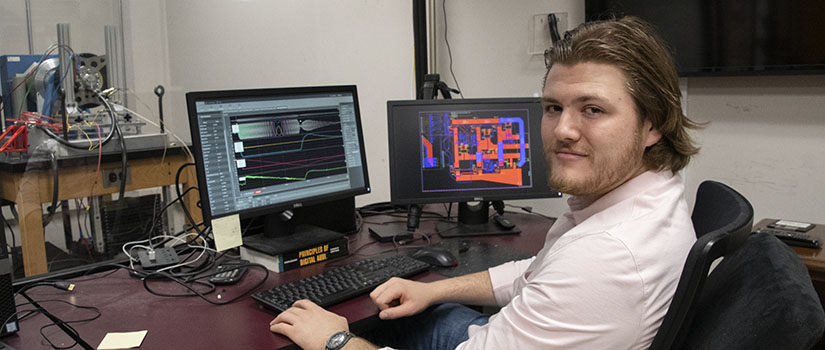Doctoral student Jack Hannum has been building a career around transportation power systems since he was an undergraduate in the Molinaroli College of Engineering and Computing. Now a full-time graduate research assistant under Electrical Engineering Assistant Professor Kristen Booth, he studies digital twins for naval power systems and electric vertical take-off and landing (eVTOL) aircraft powertrains for NASA.
Hannum started as an undergraduate researcher for Booth during his senior year and continued his work while transitioning into the electrical engineering Ph.D. program. His research focuses on the efficiency of power systems in vehicles such as naval ships, spacecraft and electronic vehicles.
“Jack is a self-motivated and dedicated student who has found his niche in the world,” Booth says. “He is an asset to my team and has been a pleasure to mentor for the past four years as both an undergraduate and graduate researcher. In that time, Jack has developed a power systems control methodology that enables integration of a wide variety of sources while managing the impact of the load on each source to reduce stress on each device and the overall system.”
Hannum’s work involves adapting alternating current (AC) power systems to direct current (DC) systems and the most suitable sources for powering them to reduce stress and maximize efficiency. In his research, he incorporates digital twins, which are counterparts that mirror the behavior, characteristics and performance of their physical twin. The digital twins are updated with real-time data and used for simulation, integration, testing, monitoring, and maintenance.
“In many cases we have to invert the DC power through a converter, but that imposes additional losses on the system,” Hannum says. “We want to directly interface batteries with these power systems and do so with higher efficiency. By using DC distribution, we eliminate a lot of the converters. It’s like taking an American appliance to Europe and not having to run it through a converter.”
As an undergraduate, Hannum was the founder and president of Gamecock GP, the university’s Formula Society of Automotive Engineers (SAE) team that competes in the organization’s annual competition. During his tenure, he led the team’s 30 members in the design-build of a Formula SAE Electric race car and organized sub-teams to focus on different systems. In addition to designing a car, the team gained project management and design experience and made valuable connections in the automotive sector through events with the Carolina section of SAE International.
Hannum’s work with Gamecock GP influenced his current research. The project prompted his interest in regenerative braking, a system that converts kinetic energy back to electrical energy during deceleration, allowing it to be stored and used for later propulsion.
“Gamecock GP is what first got me interested in regenerative breaking, which is a major focus of the NASA eVTOL project and whether it will allow us to reduce weight and increase performance in take-off and landing,” Hannum says.
Hannum previously interned with aerospace company SpaceX in 2023 and 2024. He will earn his Ph.D. this August and continue his career at SpaceX as a power electronics engineer.
“I find it very satisfying to see the transportation applications around power systems and the capabilities we can enable,” he says.
